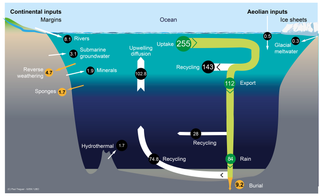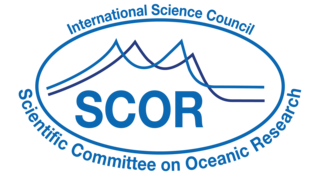Geochemistry is the science that uses the tools and principles of chemistry to explain the mechanisms behind major geological systems such as the Earth's crust and its oceans. The realm of geochemistry extends beyond the Earth, encompassing the entire Solar System, and has made important contributions to the understanding of a number of processes including mantle convection, the formation of planets and the origins of granite and basalt. It is an integrated field of chemistry and geology.

A biogeochemical cycle, or more generally a cycle of matter, is the movement and transformation of chemical elements and compounds between living organisms, the atmosphere, and the Earth's crust. Major biogeochemical cycles include the carbon cycle, the nitrogen cycle and the water cycle. In each cycle, the chemical element or molecule is transformed and cycled by living organisms and through various geological forms and reservoirs, including the atmosphere, the soil and the oceans. It can be thought of as the pathway by which a chemical substance cycles the biotic compartment and the abiotic compartments of Earth. The biotic compartment is the biosphere and the abiotic compartments are the atmosphere, lithosphere and hydrosphere.

Biogeochemistry is the scientific discipline that involves the study of the chemical, physical, geological, and biological processes and reactions that govern the composition of the natural environment. In particular, biogeochemistry is the study of biogeochemical cycles, the cycles of chemical elements such as carbon and nitrogen, and their interactions with and incorporation into living things transported through earth scale biological systems in space and time. The field focuses on chemical cycles which are either driven by or influence biological activity. Particular emphasis is placed on the study of carbon, nitrogen, oxygen, sulfur, iron, and phosphorus cycles. Biogeochemistry is a systems science closely related to systems ecology.
Isotopic labeling is a technique used to track the passage of an isotope through chemical reaction, metabolic pathway, or a biological cell. The reactant is 'labeled' by replacing one or more specific atoms with their isotopes. The reactant is then allowed to undergo the reaction. The position of the isotopes in the products is measured to determine what sequence the isotopic atom followed in the reaction or the cell's metabolic pathway. The nuclides used in isotopic labeling may be stable nuclides or radionuclides. In the latter case, the labeling is called radiolabeling.
The Global Climate Observing System (GCOS) was established in 1992 as an outcome of the Second World Climate Conference, to ensure that the observations and information needed to address climate-related issues are obtained and made available to all potential users. The GCOS is co-sponsored by the World Meteorological Organization (WMO), the Intergovernmental Oceanographic Commission (IOC) of UNESCO, the United Nations Environment Programme (UNEP), and the International Council for Science (ICSU). In order to assess and monitor the adequacy of in-situ observation networks as well as satellite-based observing systems, GCOS regularly reports on the adequacy of the current climate observing system to the United Nations Framework Convention on Climate Change (UNFCCC), and thereby identifies the needs of the current climate observing system.
The World Ocean Circulation Experiment (WOCE) was a component of the international World Climate Research Program, and aimed to establish the role of the World Ocean in the Earth's climate system. WOCE's field phase ran between 1990 and 1998, and was followed by an analysis and modeling phase that ran until 2002. When the WOCE was conceived, there were three main motivations for its creation. The first of these is the inadequate coverage of the World Ocean, specifically in the Southern Hemisphere. Data was also much more sparse during the winter months than the summer months, and there was—and still is to some extent—a critical need for data covering all seasons. Secondly, the data that did exist was not initially collected for studying ocean circulation and was not well suited for model comparison. Lastly, there were concerns involving the accuracy and reliability of some measurements. The WOCE was meant to address these problems by providing new data collected in ways designed to "meet the needs of global circulation models for climate prediction."
The Global Ocean Data Analysis Project (GLODAP) is a synthesis project bringing together oceanographic data, featuring two major releases as of 2018. The central goal of GLODAP is to generate a global climatology of the World Ocean's carbon cycle for use in studies of both its natural and anthropogenically forced states. GLODAP is funded by the National Oceanic and Atmospheric Administration, the U.S. Department of Energy, and the National Science Foundation.
Marine chemistry, also known as ocean chemistry or chemical oceanography, is the study of the chemical composition and processes of the world’s oceans, including the interactions between seawater, the atmosphere, the seafloor, and marine organisms. This field encompasses a wide range of topics, such as the cycling of elements like carbon, nitrogen, and phosphorus, the behavior of trace metals, and the study of gases and nutrients in marine environments. Marine chemistry plays a crucial role in understanding global biogeochemical cycles, ocean circulation, and the effects of human activities, such as pollution and climate change, on oceanic systems. It is influenced by plate tectonics and seafloor spreading, turbidity, currents, sediments, pH levels, atmospheric constituents, metamorphic activity, and ecology.
Meinrat O. Andreae, born in 1949 in Augsburg, is a German biogeochemist. Since 1987, he has worked as Director and Scientific Member at the Max Planck Institute for Chemistry (MPIC) in Mainz.
Sunil Kumar Singh is a leading Indian geochemist, a Professor at the Physical Research Laboratory on lien and served as Director of the National Institute of Oceanography, India from 2017 till 2029. He is known for his studies on low temperature elemental and isotope geochemistry and his researches are reported to have assisted in widening the understanding of the evolution of the Himalayas. His studies have been documented in several peer-reviewed articles; Google Scholar, an online repository of scientific articles, has listed 99 of them respectively.

Marine biogeochemical cycles are biogeochemical cycles that occur within marine environments, that is, in the saltwater of seas or oceans or the brackish water of coastal estuaries. These biogeochemical cycles are the pathways chemical substances and elements move through within the marine environment. In addition, substances and elements can be imported into or exported from the marine environment. These imports and exports can occur as exchanges with the atmosphere above, the ocean floor below, or as runoff from the land.
The Atlantic Meridional Transect is a multi-decadal oceanographic programme that undertakes biological, chemical and physical research during annual voyages between the UK and destinations in the South Atlantic. The ongoing AMT programme was begun in 1995 to assess biological processes in the Atlantic Ocean from the mesoscale through to basin-scale. An early activity of the programme was the calibration of measurements and products produced by the SeaWiFS (1997-2010) satellite-based sensor for ocean chlorophyll.
Tina van de Flierdt is a Professor of Isotope Geochemistry at Imperial College London.

The silica cycle is the biogeochemical cycle in which biogenic silica is transported between the Earth's systems. Silicon is considered a bioessential element and is one of the most abundant elements on Earth. The silica cycle has significant overlap with the carbon cycle and plays an important role in the sequestration of carbon through continental weathering, biogenic export and burial as oozes on geologic timescales.
Bess Ward is an American oceanographer, biogeochemist, microbiologist, and William J. Sinclair Professor of Geosciences at Princeton University.
Trace metal stable isotope biogeochemistry is the study of the distribution and relative abundances of trace metal isotopes in order to better understand the biological, geological, and chemical processes occurring in an environment. Trace metals are elements such as iron, magnesium, copper, and zinc that occur at low levels in the environment. Trace metals are critically important in biology and are involved in many processes that allow organisms to grow and generate energy. In addition, trace metals are constituents of numerous rocks and minerals, thus serving as an important component of the geosphere. Both stable and radioactive isotopes of trace metals exist, but this article focuses on those that are stable. Isotopic variations of trace metals in samples are used as isotopic fingerprints to elucidate the processes occurring in an environment and answer questions relating to biology, geochemistry, and medicine.

The lithium cycle (Li) is the biogeochemical cycle of lithium through the lithosphere and hydrosphere.

The Scientific Committee on Oceanic Research (SCOR) is an interdisciplinary body of the International Science Council. SCOR was established in 1957, coincident with the International Geophysical Year of 1957-1958. It sought to bring scientists together to answer key ocean science questions and improve opportunities for marginalised scientists.
Catherine Jeandel is a French geochemical oceanographer known for her research on isotope geochemistry and trace elements in the ocean.
Zanna Chase is an ocean-going professor of chemical oceanography and paleoceanography at the Institute of Marine and Antarctic Science, University of Tasmania, Australia. She has undertaken over 20 voyages on research vessels, and her areas of expertise are Antarctic paleoclimate, marine carbon cycle, radionuclides in the ocean, sediment geochemistry, paleoceanography, and marine biogeochemistry. In 2013 she was awarded an ARC Future Fellowship.




